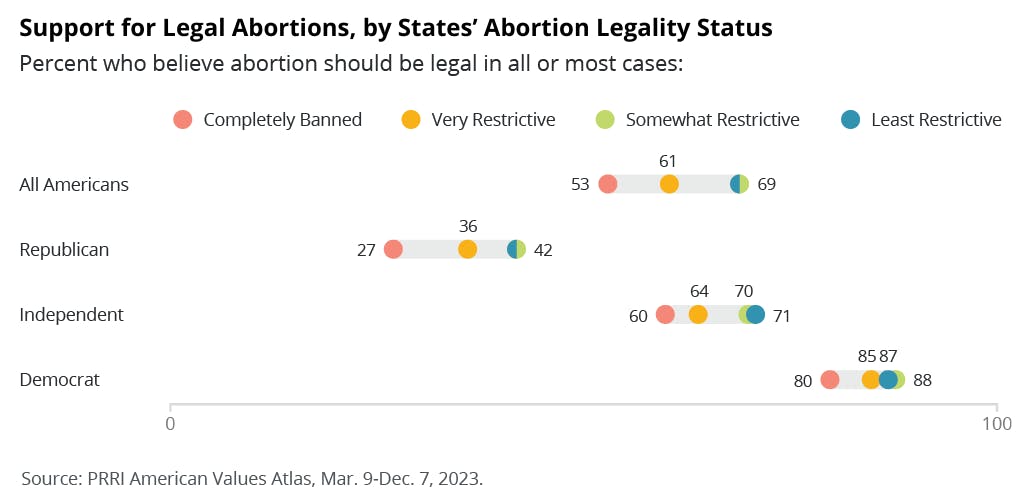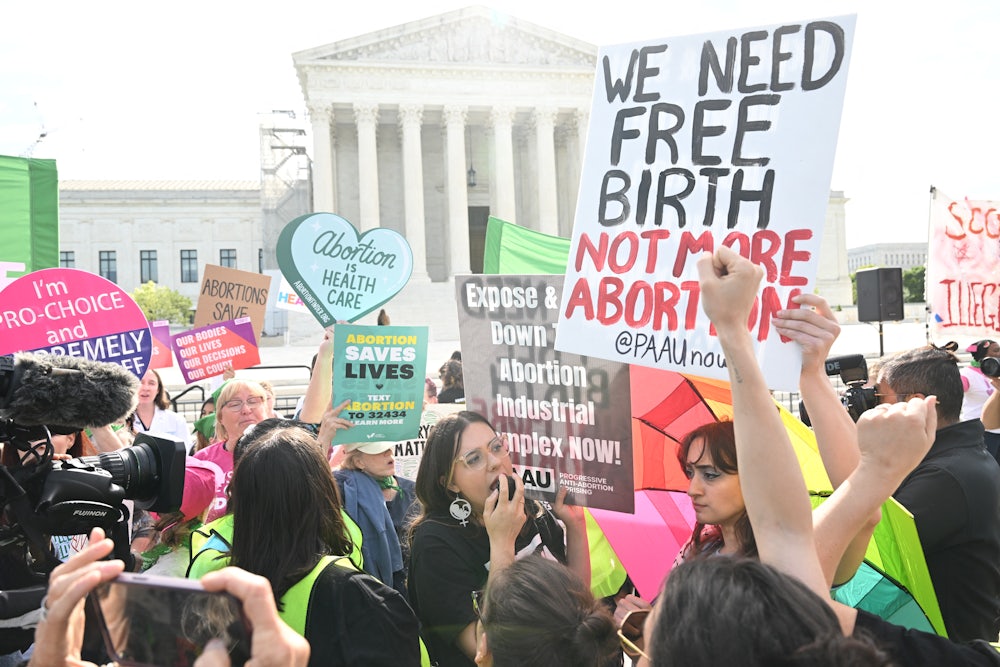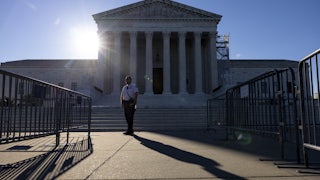With states now firmly in control of laws determining abortion access, the last several years have seen a rash of increasingly restrictive state-level policies. While the Supreme Court preserved women’s access to the abortion pill earlier this month, its decision was a narrow one; lawmakers in red states will continue attempts to ban mifepristone or seek to restrict abortion access in other ways. The Supreme Court’s ruling on emergency abortions due to dire pregnancy complications in Idaho may likewise offer only a temporary reprieve: The Supreme Court merely lifted a stay that had blocked the policy in the wake of Idaho’s strict ban on virtually all abortions and remanded the case back to the lower courts.
Draconian abortion policies continue to threaten access to reproductive rights in many parts of the country, despite widespread opposition. A national survey released this spring by my organization, Public Religion Research Institute, or PRRI, helps explain both why some states continue to enact laws the electorate dislikes and why reproductive rights will continue to be an increasingly salient issue for voters.
Make no mistake—the types of restrictive abortion laws that have drawn national scrutiny in red states are extremely unpopular with Americans. PRRI’s American Values Atlas finds that, nationally, only 9 percent of Americans support making abortion illegal in all cases. Moreover, just 11 percent of residents in the 14 states that have essentially banned the procedure say that abortion should be illegal in all cases. Put differently, more than half of Americans (53 percent) who live in states with virtually no access to legal abortion support abortion’s legality in all or most cases.
So why is there this discrepancy between polling and policy? The answer has to do with the disproportionate influence of more extreme voters—as well as the growing ascendancy of religious conservatives as Republican Party power brokers.
To be clear, most Republicans have never championed reproductive rights: Only around one-third of Republicans (36 percent) surveyed in 2023 supported abortion legality—virtually unchanged from 2010 when PRRI first started polling on Americans’ abortion views. However, Republicans in states with the most stringent abortion restrictions hold significantly more conservative views than other Republicans. In states where abortion is banned, Republicans are 15 percentage points less likely to say that abortion should be legal in most or all cases compared with Republicans who live in states with somewhat restrictive or the least restrictive abortion policies (27 percent versus 42 percent, respectively).

While opposition to abortion has long been linked to conservative religious views, the growing influence of Christian nationalism within the GOP means that there is little incentive in the near term for red states with abortion bans to change course. PRRI analysis shows that overall, the higher a state’s residents scored on PRRI’s Christian nationalism scale, the less likely those residents are to support legal abortion.
Simply asking people whether they think abortion should be legal, however, doesn’t capture the complexity of abortion’s impact on national elections. When PRRI first asked Americans in 2018 whether they would only vote for a candidate who shared their view on abortion, Republicans who opposed abortion legality in 2018 were significantly more likely than Democrats who supported abortion legality to say that they would only vote for candidates who shared their views (34 percent versus 25 percent, respectively).
Today, we find that 50 percent of Democrats who support abortion legality view abortion as a critical litmus test issue, now at a higher rate than Republicans who oppose abortion rights (44 percent). Yet the 10-point increase among Republican abortion opponents who view abortion as key to their voting choices also shows the recalcitrant nature of the abortion debate. Many Republican base voters indicate more willingness to keep these hard-fought, restrictive policies in place in certain states—however unpopular they are with their state’s residents.
Nonetheless, Republican candidates are likelier to pay a steep political price nationally for backing abortion bans. Many analysts credit the abortion issue with driving larger than expected turnout among younger women in the 2022 midterms, which mitigated Democratic losses in the House and helped ensure that Democrats retained majority control in the Senate. While midterm voters cited inflation, crime, and other factors as important to their choices, Tufts University’s analysis found that only voters under 30 cited abortion as their number one issue, with young women significantly more likely to do so than young men.
It is little wonder, then, that reproductive rights activists are working hard to place initiatives concerning abortion rights onto state ballots. While this is a particularly potent tactic for driving turnout in an election year when younger voters are less than enthusiastic about either presidential candidate, growing polarization on this and other issues does not bode well for the health of our democracy—especially given that many states don’t allow citizen-led measures on ballots.
Only time will tell if heightened election rhetoric and debates over reproductive health drive Americans further apart or cultivate greater consensus. What is certain is that even beyond 2024, access to abortion, with its repercussions for Americans’ health, well-being, and futures, will continue to be a deciding factor in elections for years to come.








